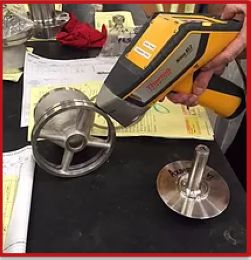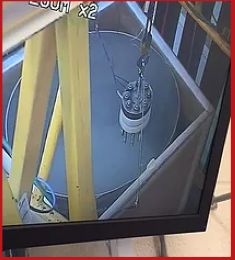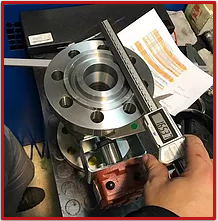Valve tests are necessary to check the performance of valves (at specified temperature).
Does the valve meet the requirements according to:
Cycling: what is the torque to open and close the valve
Seat tests: what is the seat leakage of a valve
Shell or body test (Fugitive Emission): what is the leak rate for parts, like: seals, joints and gaskets
Valve testing or inspections at the our clients’ location or field testing are also services of VIP VALVE.
Examples of valve test standards and procedures:
Type Approval Testing:
ISO 15848-1: Industrial valve -Measurement, test and qualification procedures for fugitive emissions, Part 1: Classification system and qualification procedures for type testing of valves
SHELL (TAT) SPE 77/300: Shell FE-prototype acceptance testing
BS6364: Specification for valves for cryogenic service
TA-Luft: The TA Luft is a comprehensive air pollution control regulation for e.g. valves;
API 622: Fugitive Emission packing test in a test fixture using methane as test gas
API 624, a new American Fugitive Emission test of a API 622 packing for gate and globe valves using methane as test gas.
API 6A PR1 and PR2 are reliable tests of the most critical valves or other components.
VIP VALVE has tested gate, globe, check, choke and ball valves.
These tests were performed to test the integrity of these valves can withstand the most arduous environments using gas test pressures up to 25,000 psi.
These tests evaluate the to be tested valves to high and low temperatures whilst dynamically cycling it under various pressure conditions.
Production Testing:
Depending the client requirements, critical valves can be subjected to 100% testing. Valve tests are necessary to check the performance of valves (at specified temperature).
Does the valve meet the requirements according to:
Cycling: what is the torque to open and close the valve
Seat tests: what is the seat leakage for a bi- or unidirectional valves
Shell or body test (Fugitive Emission): what is the leak rate for parts, like: seals, joints and gaskets
Examples of typical production tests:
ISO 15848-2: Measurement, test and qualification procedures for fugitive emissions, Part 2: Production acceptance test of valves
ISO 5208: specifies examinations and tests that a valve manufacturer needs to act upon in order to establish the integrity of the pressure boundary of an industrial metallic valve and to verify the degree of valve closure tightness and the structural adequacy of its closure mechanism.
API 598: Valve Inspection and Testing. The standard covers inspection, supplementary examination, and pressure test requirements for both resilient-seated and metal-to-metal seated gate, globe, plug, ball, check, and butterfly valves.
EN 12266: Industrial valves - Testing of metallic valves - Part 1: Pressure
tests, test procedures and acceptance criteria - Mandatory requirements. Part 2: Tests, test procedures and acceptance criteria - Supplementary requirements
BS6755: Testingof Valves - Part 1: Specification for ProductionPressure Testing.
MESC SPE 77-200: Valves in service below minus -50°C
MESC SPE 77-209: Valves in services between zero and -50°C
MESC SPE 77/302 Material Acceptance Requirements for Valves in General Service
MESC SPE 77/303 Material Acceptance Requirements for Valves in Special Service
MESC SPE 77-306:a supplement to BS 6364 and EN 1626standards, regarding cryogenic (-196°C) and low temperature (-46°C) productiontesting of valves for seat and/or shell tightness
MESC SPE 77-307: Valves for vacuum services
SPE 77-308: Test procedure for valves in Hydrogen or H2S Services
Shell SPE 77-312: Shell FE-production acceptance testing
ISO 15848-2: Measurement, test and qualification procedures for fugitive emissions, Part 2: Production acceptance test of valves
Fire Safe Testing:
Meanwhile VIP VALVE has tested hundreds of valves according to most common standards: API standards (607, 6FA, 6FB, 6FD) and ISO (10497, 19922)
Does the valve meet the requirements according to:
Cycling: what is the torque to open and close the valve
Seat tests: what is the seat leakage of a valve
Shell or body test (Fugitive Emission): what is the leak rate for parts, like: seals, joints and gaskets
Valve testing or inspections at the our clients’ location or field testing are also services of VIP VALVE.
Examples of valve test standards and procedures:
Type Approval Testing:
ISO 15848-1: Industrial valve -Measurement, test and qualification procedures for fugitive emissions, Part 1: Classification system and qualification procedures for type testing of valves
SHELL (TAT) SPE 77/300: Shell FE-prototype acceptance testing
BS6364: Specification for valves for cryogenic service
TA-Luft: The TA Luft is a comprehensive air pollution control regulation for e.g. valves;
API 622: Fugitive Emission packing test in a test fixture using methane as test gas
API 624, a new American Fugitive Emission test of a API 622 packing for gate and globe valves using methane as test gas.
API 6A PR1 and PR2 are reliable tests of the most critical valves or other components.
VIP VALVE has tested gate, globe, check, choke and ball valves.
These tests were performed to test the integrity of these valves can withstand the most arduous environments using gas test pressures up to 25,000 psi.
These tests evaluate the to be tested valves to high and low temperatures whilst dynamically cycling it under various pressure conditions.
Production Testing:
Depending the client requirements, critical valves can be subjected to 100% testing. Valve tests are necessary to check the performance of valves (at specified temperature).
Does the valve meet the requirements according to:
Cycling: what is the torque to open and close the valve
Seat tests: what is the seat leakage for a bi- or unidirectional valves
Shell or body test (Fugitive Emission): what is the leak rate for parts, like: seals, joints and gaskets
Examples of typical production tests:
ISO 15848-2: Measurement, test and qualification procedures for fugitive emissions, Part 2: Production acceptance test of valves
ISO 5208: specifies examinations and tests that a valve manufacturer needs to act upon in order to establish the integrity of the pressure boundary of an industrial metallic valve and to verify the degree of valve closure tightness and the structural adequacy of its closure mechanism.
API 598: Valve Inspection and Testing. The standard covers inspection, supplementary examination, and pressure test requirements for both resilient-seated and metal-to-metal seated gate, globe, plug, ball, check, and butterfly valves.
EN 12266: Industrial valves - Testing of metallic valves - Part 1: Pressure
tests, test procedures and acceptance criteria - Mandatory requirements. Part 2: Tests, test procedures and acceptance criteria - Supplementary requirements
BS6755: Testingof Valves - Part 1: Specification for ProductionPressure Testing.
MESC SPE 77-200: Valves in service below minus -50°C
MESC SPE 77-209: Valves in services between zero and -50°C
MESC SPE 77/302 Material Acceptance Requirements for Valves in General Service
MESC SPE 77/303 Material Acceptance Requirements for Valves in Special Service
MESC SPE 77-306:a supplement to BS 6364 and EN 1626standards, regarding cryogenic (-196°C) and low temperature (-46°C) productiontesting of valves for seat and/or shell tightness
MESC SPE 77-307: Valves for vacuum services
SPE 77-308: Test procedure for valves in Hydrogen or H2S Services
Shell SPE 77-312: Shell FE-production acceptance testing
ISO 15848-2: Measurement, test and qualification procedures for fugitive emissions, Part 2: Production acceptance test of valves
Fire Safe Testing:
Meanwhile VIP VALVE has tested hundreds of valves according to most common standards: API standards (607, 6FA, 6FB, 6FD) and ISO (10497, 19922)




